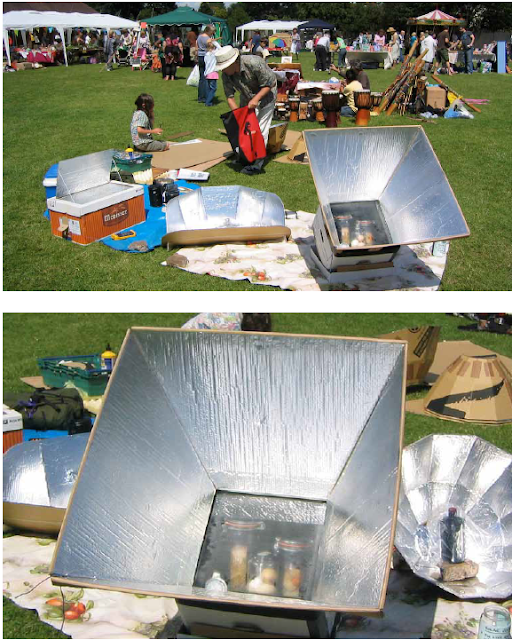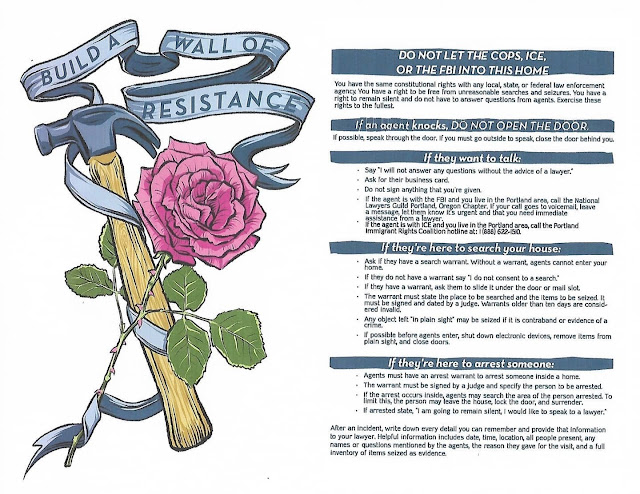Cooking with Solar Ovens
We use the sun's energy all the time. It gives us light. It makes plants grow. It dries our clothes. We use it to make electricity. And we can cook with it!
Energy from the sun reaches the Earth as radiant energy. We can turn this energy into heat for cooking. A solar oven focuses the sun's energy onto a dark cooking pot. The oven is made of a
light, shiny material that reflects the rays. The dark cooking pot absorbs the radiant energy and converts it into heat.
The clear plastic bag around the pot creates a greenhouse effect. The radiant energy passes through the plastic to the pot. The radiant energy turns into heat energy. The heat energy cannot
pass out through the plastic. The heat stays in the bag and cooks the food in the pot. People all over the world use solar ovens. Campers use them instead of campfires. No risk of forest fires! No smoke in your eyes! No marshmallows! What? Okay, so solar ovens can't do everything. But, you can put your dinner in the oven and go for a long hike. The food cooks all by itself-no watching, stirring, or turning needed. And the food won't burn if you're an hour late getting back to camp.
In Third World countries, wood is still the main fuel for cooking. Many families spend hours every day trying to find wood for the evening meal. As the trees disappear, their lives become harder
and harder. And their land becomes a desert.
Solar ovens can free these families from hours of work. The ovens are easy to use and affordable. Simple ovens can be made for a few dollars. But you can't just give a family a solar oven and expect them to use it.
Training is very important. Most people are used to stirring their food often, especially over a wood fire. With a solar oven, it's important to keep the cooking pot closed. Too much heat escapes
when it is opened. It's hard to convince people that food can cook for hours in a solar oven without burning.
At a refugee camp in Kenya, a special program is underway. Refugees who plant 25 trees and take care of them for three months are given a solar oven. There are similar programs in other parts of Africa, China, Nepal, and Costa Rica.
Some solar ovens are big and fancy. The Army used giant solar ovens mounted on trucks during the Gulf War. The ovens cooked meals for hundreds of troops. National Guard camps are also using big solar ovens for cooking.
It's easy to cook with solar and the fuel is free, renewable and non-polluting. You can even use a solar oven in the winter on a bright, sunny day. Just add some insulation under the oven and protect it from the wind. The food will take longer to cook, but that's no problem. Just start your dinner in the morning and turn the oven a few times to make sure it's facing the sun.
You can't broil in a solar oven, but you can bake, boil and roast. You can even pasteurize water. Simple solar ovens made of cardboard boxes can reach 3250 F. You can make almost all of your favorite foods without changing the recipes much.
Making a Solar Oven
Tips for cooking with a solar oven:
1. Think dark! Use black metal pans and dark brown glass dishes. Never use light colored cookware. A canning jar painted flat black works fine to boil water.
2. Use an oven thermometer. It will help you figure out how long to cook things.
3. Use black cast iron if you're cooking something that must be stirred. It won't lose as much heat when you open the lid.
4. Don't add water when roasting vegetables. Use a pan with a lid and they'll cook in their own juices.
5. When baking potatoes, rub with oil and put in a pot with a lid. Don't wrap with aluminum.
6. Bake bread in dark glass dishes with lids. If you use a cookie sheet, it won't have a nice crust.
7. When baking cookies: chocolate cooks fastest, then peanut butter, then sugar cookies. Use a dark cookie sheet!
8. Marinate meats in advance. Place on a rack in a cast iron pot.
9. One pot meals are great! Cut everything up, throw it into the pot, put a lid on and walk away.
10. Remember-food won't burn in a solar oven. It might lose too much water, though, if you cook it too long.
Materials
- Tri-fold presentation board
- Sharp knife or scissors to cut board
- Wide, heavy-weight aluminum foil
- Glue stick and clear packing tape
- Clear plastic bags (Oven cooking bags)
- Cooking pot
Procedure.
• Cut board according to the diagram.
• Lightly score new fold lines before folding.
• Use tape to reinforce folds and to straighten pre-fold on wings.
• Cover entire board front with aluminum foil, taping or gluing securely.
• Slide points of wings into slits as shown in the diagram.
• Enclose cooking pot in plastic bag and place in middle of oven.
*Optional. Use pizza boxes covered with foil to make mini-ovens.






Comments
Post a Comment